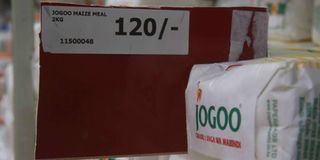Imported maize to ease shortage, reduce prices

The price of maize flour is expected to reduce when the government imports maize from Mexico. PHOTO | JOSEPH KANYI | NATION MEDIA GROUP
What you need to know:
- The government has allowed the importation of two million bags of white maize for human consumption and another two million bags of yellow maize for animal feeds.
- Agriculture Principal Secretary Hamadi Boga said the duty imposed was to protect local maize farmers, who might still be having maize to sell.
Kenyans should expect reprieve from an anticipated hike in maize-meal prices after the millers’ association said a consignment of maize from Mexico was on the way and would forestall a shortage.
This comes after the government and millers finally reached a consensus on import conditions. “We expect the first shipment of yellow and white maize anytime from mid-June. It’s expected to get to our mills by early July after all the formalities of discharging, offloading, handling and transportation to various parts of the country,” Cereal Millers Association Chief Executive Officer Paloma Fernandes told the Nation at the weekend.
The government has allowed the importation of two million bags of white maize for human consumption and another two million bags of yellow maize for animal feeds at 14 per cent and 10 per cent duty, respectively.
The millers had warned last month that Kenyans should expect the price of maize flour to increase by up to Sh30, following an acute maize shortage in the country after the National Cereals and Produce Board exhausted its stock.
For close to a month, the millers had been locked in a battle with the government over the deadline for importing the staple.
OMTATAH SUES
The government gave the millers a deadline of May 30, but they protested that it was too soon untenable
The initial Kenya Gazette notice granting millers permission to import came out on April 20, and allowed importation before May 30.
Yet it takes about 60 days from the date the maize is ordered to the day it arrives in the country from Mexico.
After negotiations, the government agreed to push the deadline back to July 31 after rejecting the association’s earlier request to extend the deadline to September 30.
At the same time, a consumer lobby represented by activist Okiya Omtatah went to court challenging the gazette notice. It argued that the government authorised the importation of dry maize that does not meet the East African Community standards.
Mr Omtatah argued that the notice allowed for the importation of maize, whose aflatoxin levels don’t exceed 10 parts per million, instead of the required standard of 10 parts per billion, which was 1,000 times higher than what the law permits.
MAIZE QUALITY
He also said the notice specified that the imported maize should have a moisture content not exceeding 14.5 per cent, yet the EAC sets a maximum of 13.5 per cent for safety for human consumption.
“The standards have also been amended to ensure that they comply with Kenya Bureau of Standards (Kebs) standards,” Ms Fernandes said.
“Thanks to this timely intervention, we don’t see a shift either upwards or downwards, but expect the price to stabilise once the imported maize arrives and starts getting milled as the price of imported maize is similar to the price of local maize.
“In the meantime, we expect farmers and brokers to release some of their maize in anticipation of the imports, as well as supplies from Tanzania, which will serve to cover some part of the deficit, expected.” She added: “We also expect good harvests in Kenya in late August-early September.”
PLANNED HARVEST
Agriculture Principal Secretary Hamadi Boga said the duty imposed was to protect local maize farmers, who might still be having maize to sell.
“The millers are importing to mill for the market because of the anticipated tightness in supply around June-July since we will not have started harvesting then.
Flows from the neighbouring countries, though trickling in, are challenged due to the current goings-on. But harvesting in the Rift begins in August and September,” the PS said.
“Currently, because of too much rain, the levels of rejection of maize by millers due to aflatoxin has been, and is expected, to be high,” he added.
Kenya consumes 4.2 million bags of maize per month.




